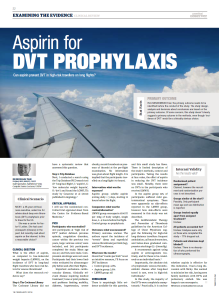 This article was published in Medical Observer.
This article was published in Medical Observer.
The article is also available on the Medical Observer website (may need registration).
Clinical scenario
Nicky, a 48-year-old business executive, asked me for advice about DVT prophylaxis prior to travel to the US. She was a carrier for factor V Leiden. She had used enoxaparin (Clexane) in the past, but recently read about aspirin on the internet. Is this a reasonable choice?
Clinical question
What is the effect of aspirin, as compared to low-molecular weight heparin (LMWH), on the incidence of DVT in long-haul flight travellers who have risk factors for venous thrombosis?
What does the research evidence say?
Step 1: The Cochrane Library
The Cochrane Library did not have a systematic review that answered this question.
Step 2: TripDatabase
Next, I conducted a search using the TripDatabase PICO search tool (P: “long haul flight”, I: “aspirin”, C: “low molecular weight heparin”, O: “dvt”) and found the LONFLIT3 study by Cesarone et al. (2002) published in Angiology [1]. Let’s look at this study in detail.
Critical appraisal
I will use the randomised controlled trial appraisal sheet from the Centre for Evidence Based Medicine [2].
PICO
Participants: who was studied?
300 participants (of 467 contacted) at “high risk of DVT” (author defined: previous episode, coagulation disorders, cancer within the previous 2 years, large varicose veins) [1] were included, and 249 participants completed the study. Their mean age was 47 years, and 65% were male. Compression stockings were not used in this study. Participants had their lower limb veins evaluated by ultrasonography before and after their flights.
Important exclusions: cardiovascular disease, “clinically relevant disease requiring medical treatment”, bone or joint problems and problems limiting mobility, diabetes, hypertension, severe obesity, recent thrombosis or presence of thrombi at the pre-flight examination.
No information was given about flight length. It is implied that the participants travelled on a “long flight” (> 10 hours) but this isn’t stated explicitly.
Intervention: what was the exposure?
Aspirin group:
soluble aspirin 400 mg daily × 3 days, starting 12 hours before the flight
Comparator: what was the control/alternative?
LMWH group:
enoxaparin 1000 IU per 10 kg of body weight, single dose, injected 2-4 hours before the flight
Control group:
no prophylaxis
Outcomes: what was measured?
Primary outcome: unclear (see Stat Facts). The authors report the incidence of “events” (deep and superficial venous thrombosis) per limb (leg), and DVT incidences.
Internal validity: are the trial results valid?
Randomised patient assignment?
Yes/claimed. The recruitment and randomisation process is not described.
Groups similar at the start?
Possibly. Only participant mean age and sex distribution is reported.
Groups treated equally apart from assigned treatment?
Unclear. Little information is given about the participants.
All patients accounted for?
Unclear. Analyses were only on those who completed the study – 17% dropped out.
Measures objective? Or patients and clinicians kept blinded?
Unclear. The study was not blinded. The paper does not describe who performed the ultrasonography.
What were the results?
Given that “events per limb” is not an intuitive measure, I’ll focus on DVT incidence:
- control group: 4.8%
- aspirin group: 3.6%
- LMWH group: nil
Conclusion
There is surprisingly little evidence available for this question, and this small study has flaws. Its interpretation is hampered by the limited description of the study’s methods, context, and participants. Taking the results at face-value, the effect of aspirin in reducing the DVT incidence in this high risk population was small. Notably, there were no DVTs in the participants who received LMWH.
Thirteen percent of participants in the aspirin group suffered mild gastrointestinal symptoms. There were apparently no side-effects reported in the LMWH group. However, these results need to be considered cautiously – how side-effects were measured in this study was not described.
The Antithrombotic Therapy and Prevention of Thrombosis guidelines by the American College of Chest Physicians (ACCP) suggest the following clinical care recommendations for high risk long-distance travellers: frequent ambulation, calf muscle exercises, and below-knee graduated compression stockings (15-30 mmHg). It recommends against using aspirin or anticoagulants routinely, and for these to be considered on an individual basis [3]. Importantly, the absolute risk of symptomatic venous thromboembolic disease after long-haul travel is rare, even in high risk individuals [3]. In this study, the majority of the DVTs were completely asymptomatic [1].
Practically, it is unclear whether aspirin is effective for this indication. I had a long discussion with Nicky. She wanted to minimise her risk, having seen family members with DVTs and pulmonary emboli. She was happy to use enoxaparin.
Stat Facts
Primary outcome
In a randomised trial, the primary outcome needs to be identified and chosen before the conduct of the study. The study design, analysis, and decisions about conclusions are based on the primary outcome. Of some concern, this study doesn’t clearly suggest a primary outcome in the methods, even though “incidence of DVT” would be clinically obvious choice.
References
- Cesarone MR, Belcaro G, Nicolaides AN, et al. Venous thrombosis from air travel: the LONFLIT3 study–prevention with aspirin vs low-molecular-weight heparin (LMWH) in high-risk subjects: a randomized trial. Angiology 2002 Jan-Feb;53(1):1-6.
- Centre for Evidence-Based Medicine. Critical Appraisal tools. Available from: http://www.cebm.net/critical-appraisal/
- Kahn SR, Lim W, Dunn AS, et al. Prevention of VTE in nonsurgical patients: Antithrombotic Therapy and Prevention of Thrombosis, 9th ed: American College of Chest Physicians Evidence-Based Clinical Practice Guidelines. Chest 2012 Feb;141(2 Suppl):e195S-226S.
